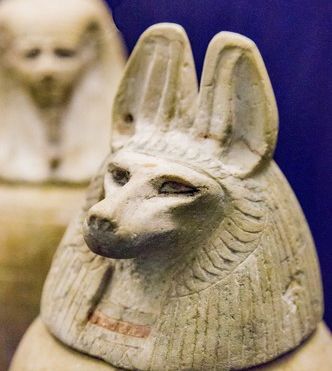
Scientists decipher DNA from organ storage vessels for the first time
(ORDO NEWS) — Scientists from the University of Zurich for the first time managed to read the DNA from the ancient Egyptian ritual vessels - canopic.
Despite the low quality of the surviving biomaterial, archaeologists were able to identify the mitochondrial haplogroups of mummified people.
Special burial vessels were used to store internal organs removed during the mummification process. Separate canopies were intended for the liver, stomach, intestines and lungs.
Further, the canopy was kept in the tomb. Usually they were made of travertine - Egyptian alabaster, but sometimes there are products from clay, faience and wood.
It is believed that canopies began to be used in the era of the Old Kingdom around 2600 BC under the pharaohs of the 5th dynasty.
At first, canopies looked like ordinary unremarkable oblong vessels, but from the end of the 3rd millennium BC, covers for them began to be made in the form of human heads.
From the 13th century BC, jugs crowned the heads of the sons of Horus - it was they who guarded the organs.
Imseti was the guardian of the liver, Hapi of the lungs, Qebehsenuf of the intestines, and Duamutef of the stomach. The organ guards, in turn, were guarded by Isis, Nephthys, Neith and Selket.
To sequence the DNA of the biomaterial, paleogeneticists studied the contents of 140 ancient Egyptian canopic canopies, which belong to museums in Europe and Great Britain.
Scientists were going not only to isolate the ancient genome, but also to detect pathogens several thousand years old.
Scientists found fragments of human DNA in 61 samples, but in 20 of them the DNA yield was insufficient. Only in 14 cases was it possible to identify qualitative values for reading chains.
In three samples, paleogeneticists managed to find sequences of human mitochondrial DNA. The sample from Croatia was haplogroup H, and the sample from Berlin was R0a1.
The first type is found among the ancient population of Egypt, but more often in modern people. The second type of haplogroup is more often present among the ancient population, but persists today.
At the same time, scientists are not in a hurry with high-profile conclusions - the risk of contamination of samples of later DNA is quite high.
And attempts to find out the fate of ancient Egyptian microbes did not bring significant results. The search revealed a number of genera of bacteria that are commonly found in the human gut microbiome.
But the quality of reading the sequences, alas, turned out to be low.
—
Online:
Contact us: [email protected]
Our Standards, Terms of Use: Standard Terms And Conditions.









